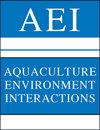温带生态系统中水产养殖与大叶藻的相互作用
IF 2.5
2区 农林科学
Q2 FISHERIES
引用次数: 4
摘要
本文综述了北半球分布最广泛的海草——大叶藻(Zostera marina)的养殖对贝类和鳍鱼的影响。贝类养殖对大叶藻有积极、中性和消极的影响。养殖双壳类的过滤作用可以产生正相互作用,这可能改善水质并减少附生菌负荷,贝类生物沉积物可能为大叶藻和其他植被提供更多的营养。然而,负面反应更常被报道,可能是由遮阳和沉积引起的。这些负面影响往往发生在贝类养殖场的正下方和周围,并随着距离的增加而迅速减少。与贝类养殖相比,只有一项实地研究调查了温带环境下鳍鱼养殖对鳗草的影响,结果不确定。然而,许多研究调查了地中海鱼类养殖场对另外两种海草(Posidonia oceanica和Cymodocea nodosa)的影响。这些研究报告了明显的负相互作用,这与营养物质浓度、硫化物、沉积、附生菌负荷和放牧压力的增加有关。由于环境条件的差异,这些研究是否与温带地区的有鳍鱼养殖有关尚不清楚,因为研究的重点是不同种类的海草。因此,在温带环境下进行进一步的研究是必要的。最后,我们强调了关键的研究空白,这些空白可以帮助监管机构建立明确的操作和选址指南,以最大限度地减少水产养殖与大鳗草之间潜在的负面相互作用。本文章由计算机程序翻译,如有差异,请以英文原文为准。
Aquaculture and eelgrass Zostera marina interactions in temperate ecosystems
This paper reviews the impacts of shellfish and finfish aquaculture on eelgrass Zostera marina, the most widely distributed seagrass species in the northern hemisphere. Shellfish aquaculture can have positive, neutral, and negative effects on eelgrass. Positive interactions can be generated by the filtering activity of cultured bivalves, which may improve water quality and reduce epiphyte loads, and shellfish biodeposits may provide more nutrients to eelgrass and other vegetation. However, negative responses are more commonly reported and can be caused by shading and sedimentation. These negative effects tend to occur directly under and immediately surrounding shellfish farms and rapidly diminish with increasing distance. In contrast to shellfish aquaculture, only one field study has investigated the effects of finfish aquaculture on eelgrass in a temperate setting, and the results were inconclusive. However, many studies have investigated the effects of Mediterranean finfish farms on 2 other species of seagrass (Posidonia oceanica and Cymodocea nodosa). These studies reported clear negative interactions, which have been linked to increased nutrient concentrations, sulphides, sedimentation, epiphyte loads, and grazing pressure. It is unknown if these studies are relevant for finfish aquaculture in temperate regions due to differences in environmental conditions, and because the studies focused on different species of seagrass. Thus, further study in a temperate setting is warranted. We conclude by highlighting key research gaps that could help regulators establish unambiguous operational and siting guidelines that minimize the potential for negative interactions between aquaculture and eelgrass.
求助全文
通过发布文献求助,成功后即可免费获取论文全文。
去求助
来源期刊

Aquaculture Environment Interactions
FISHERIES-MARINE & FRESHWATER BIOLOGY
CiteScore
4.90
自引率
13.60%
发文量
15
审稿时长
>12 weeks
期刊介绍:
AEI presents rigorously refereed and carefully selected Research Articles, Reviews and Notes, as well as Comments/Reply Comments (for details see MEPS 228:1), Theme Sections and Opinion Pieces. For details consult the Guidelines for Authors. Papers may be concerned with interactions between aquaculture and the environment from local to ecosystem scales, at all levels of organisation and investigation. Areas covered include:
-Pollution and nutrient inputs; bio-accumulation and impacts of chemical compounds used in aquaculture.
-Effects on benthic and pelagic assemblages or processes that are related to aquaculture activities.
-Interactions of wild fauna (invertebrates, fishes, birds, mammals) with aquaculture activities; genetic impacts on wild populations.
-Parasite and pathogen interactions between farmed and wild stocks.
-Comparisons of the environmental effects of traditional and organic aquaculture.
-Introductions of alien species; escape and intentional releases (seeding) of cultured organisms into the wild.
-Effects of capture-based aquaculture (ranching).
-Interactions of aquaculture installations with biofouling organisms and consequences of biofouling control measures.
-Integrated multi-trophic aquaculture; comparisons of re-circulation and ‘open’ systems.
-Effects of climate change and environmental variability on aquaculture activities.
-Modelling of aquaculture–environment interactions; assessment of carrying capacity.
-Interactions between aquaculture and other industries (e.g. tourism, fisheries, transport).
-Policy and practice of aquaculture regulation directed towards environmental management; site selection, spatial planning, Integrated Coastal Zone Management, and eco-ethics.
 求助内容:
求助内容: 应助结果提醒方式:
应助结果提醒方式:


